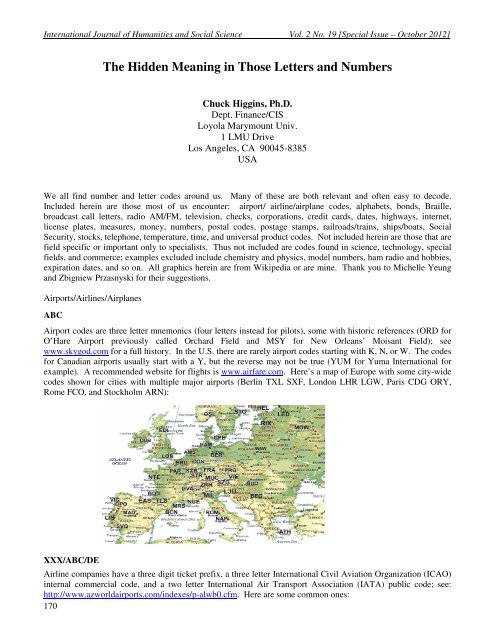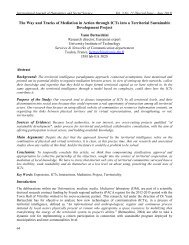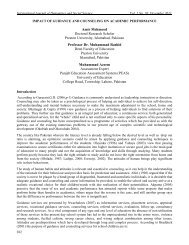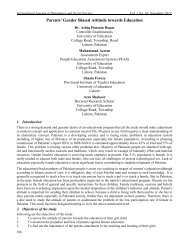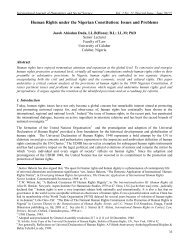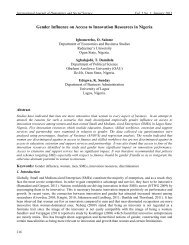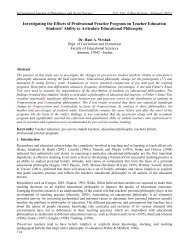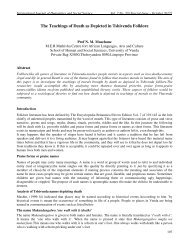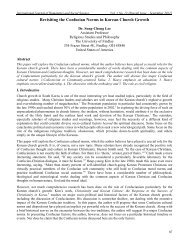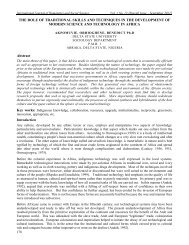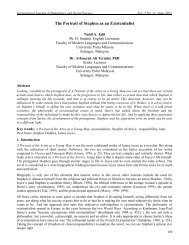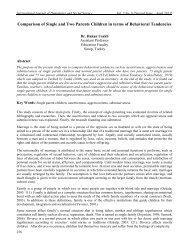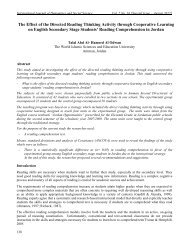The Hidden Meaning in Those Letters and Numbers - International ...
The Hidden Meaning in Those Letters and Numbers - International ...
The Hidden Meaning in Those Letters and Numbers - International ...
Create successful ePaper yourself
Turn your PDF publications into a flip-book with our unique Google optimized e-Paper software.
<strong>International</strong> Journal of Humanities <strong>and</strong> Social Science Vol. 2 No. 19 [Special Issue – October 2012]<br />
<strong>The</strong> <strong>Hidden</strong> <strong>Mean<strong>in</strong>g</strong> <strong>in</strong> <strong>Those</strong> <strong>Letters</strong> <strong>and</strong> <strong>Numbers</strong><br />
Chuck Higg<strong>in</strong>s, Ph.D.<br />
Dept. F<strong>in</strong>ance/CIS<br />
Loyola Marymount Univ.<br />
1 LMU Drive<br />
Los Angeles, CA 90045-8385<br />
USA<br />
We all f<strong>in</strong>d number <strong>and</strong> letter codes around us. Many of these are both relevant <strong>and</strong> often easy to decode.<br />
Included here<strong>in</strong> are those most of us encounter: airport/ airl<strong>in</strong>e/airplane codes, alphabets, bonds, Braille,<br />
broadcast call letters, radio AM/FM, television, checks, corporations, credit cards, dates, highways, <strong>in</strong>ternet,<br />
license plates, measures, money, numbers, postal codes, postage stamps, railroads/tra<strong>in</strong>s, ships/boats, Social<br />
Security, stocks, telephone, temperature, time, <strong>and</strong> universal product codes. Not <strong>in</strong>cluded here<strong>in</strong> are those that are<br />
field specific or important only to specialists. Thus not <strong>in</strong>cluded are codes found <strong>in</strong> science, technology, special<br />
fields, <strong>and</strong> commerce; examples excluded <strong>in</strong>clude chemistry <strong>and</strong> physics, model numbers, ham radio <strong>and</strong> hobbies,<br />
expiration dates, <strong>and</strong> so on. All graphics here<strong>in</strong> are from Wikipedia or are m<strong>in</strong>e. Thank you to Michelle Yeung<br />
<strong>and</strong> Zbigniew Przasnyski for their suggestions.<br />
Airports/Airl<strong>in</strong>es/Airplanes<br />
ABC<br />
Airport codes are three letter mnemonics (four letters <strong>in</strong>stead for pilots), some with historic references (ORD for<br />
O’Hare Airport previously called Orchard Field <strong>and</strong> MSY for New Orleans’ Moisant Field); see<br />
www.skygod.com for a full history. In the U.S. there are rarely airport codes start<strong>in</strong>g with K, N, or W. <strong>The</strong> codes<br />
for Canadian airports usually start with a Y, but the reverse may not be true (YUM for Yuma <strong>International</strong> for<br />
example). A recommended website for flights is www.airfare.com. Here’s a map of Europe with some city-wide<br />
codes shown for cities with multiple major airports (Berl<strong>in</strong> TXL SXF, London LHR LGW, Paris CDG ORY,<br />
Rome FCO, <strong>and</strong> Stockholm ARN):<br />
XXX/ABC/DE<br />
Airl<strong>in</strong>e companies have a three digit ticket prefix, a three letter <strong>International</strong> Civil Aviation Organization (ICAO)<br />
<strong>in</strong>ternal commercial code, <strong>and</strong> a two letter <strong>International</strong> Air Transport Association (IATA) public code; see:<br />
http://www.azworldairports.com/<strong>in</strong>dexes/p-alwb0.cfm. Here are some common ones:<br />
170
<strong>The</strong> Special Issue on Bus<strong>in</strong>ess <strong>and</strong> Social Science © Centre for Promot<strong>in</strong>g Ideas, USA www.ijhssnet.com<br />
(X)A<br />
Prefix ICAO IATA Airl<strong>in</strong>e<br />
001 AAL AA American Airl<strong>in</strong>es<br />
005 COA CO Cont<strong>in</strong>ental Airl<strong>in</strong>es<br />
006 DAL DL Delta Air L<strong>in</strong>es<br />
014 ACA AC Air Canada<br />
016 UAL UA United Airl<strong>in</strong>es<br />
020 GEC LH Lufthansa<br />
027 ASA AS Alaska Airl<strong>in</strong>es<br />
037 USA US US Airways<br />
042 VRG RG VARIG Brazilian Airl<strong>in</strong>es<br />
045 LAN LA LAN Airl<strong>in</strong>es<br />
047 TAP TP TAP-Air Portugal<br />
052 RPA RW Republic Airl<strong>in</strong>es<br />
053 EIN EI Aer L<strong>in</strong>gus<br />
055 AZA AZ Alitalia<br />
057 AFR AF Air France<br />
058 IAC IC Indian Airl<strong>in</strong>es<br />
074 KLM KL KLM<br />
075 IBE IB Iberia<br />
081 QFA QF Qantas Airways<br />
082 BEL SN Brussels Airl<strong>in</strong>es<br />
086 ANZ NZ Air New Zeal<strong>and</strong><br />
098 AIC AI Air India<br />
105 FIN AY F<strong>in</strong>nair<br />
114 ELY LY El Al Israel Airl<strong>in</strong>es<br />
117 SAS SK SAS Sc<strong>and</strong><strong>in</strong>avian Airl<strong>in</strong>es Systems<br />
125 BAW BA British Airways<br />
131 JAL JL Japan Airl<strong>in</strong>es<br />
132 MXA MX Mexicana de Aviación<br />
139 AMX AM Aeromexico<br />
160 CPA CX Cathay Pacific Airways<br />
173 HAL HA Hawaiian Airl<strong>in</strong>es<br />
180 KAL KE Korean Air<br />
205 ANA NH All Nippon Airways<br />
220 DLH LH Lufthansa<br />
224 RYR FR Ryanair<br />
235 THY TK Turkish Airl<strong>in</strong>es<br />
236 BMA BD bmi<br />
257 AUA OS Austrian<br />
268 AAY G4 Allegiant Air<br />
297 CAL CI Ch<strong>in</strong>a Airl<strong>in</strong>es<br />
332 TRS FL AirTran<br />
487 NKS NK Spirit Airl<strong>in</strong>es<br />
526 SWA WN Southwest Airl<strong>in</strong>es<br />
687 AAH KH Aloha Air<br />
724 SWR LX Swiss World<br />
932 VIR VS Virg<strong>in</strong> Atlantic<br />
<strong>The</strong> nationality of an airplane is determ<strong>in</strong>ed by its registration number or its flag <strong>in</strong>signia if it has one (it appears<br />
backward on the right side of the airplane consistent with the direction of flight). Airplanes have a registration<br />
letter <strong>and</strong> number; see:<br />
http://en.wikipedia.org/wiki/Aircraft_registration#List_of_countries.2Fregions_<strong>and</strong>_their_registration_prefixes_a<br />
nd_patterns . Some common letter country codes follow:<br />
171
<strong>International</strong> Journal of Humanities <strong>and</strong> Social Science Vol. 2 No. 19 [Special Issue – October 2012]<br />
Alphabets<br />
4U United Nations LX Luxembourg/NATO<br />
4X Israel N United States<br />
9M Malaysia OE Austria<br />
A6 U. A. E. OO Belgium<br />
B Ch<strong>in</strong>a (both) OY Denmark<br />
C Canada PH Netherl<strong>and</strong>s<br />
CC Chile PP-PU Brazil<br />
CR-CS Portugal<br />
RA/RF Russia<br />
D Germany SE Sweden<br />
EC Spa<strong>in</strong> SU Egypt<br />
EI Irel<strong>and</strong> TC Turkey<br />
F France TF Icel<strong>and</strong><br />
G United K<strong>in</strong>gdom VH Australia<br />
HB Switzerl<strong>and</strong> VT India<br />
HL S. Korea XA-XC Mexico<br />
I Italy ZK New Zeal<strong>and</strong><br />
JA Japan ZS-ZU South Africa<br />
Alphabets differ among languages. Notable is that the modern usage of computers <strong>and</strong> English <strong>in</strong> the travel<br />
<strong>in</strong>dustry has resurrected the orig<strong>in</strong>al characters. Moreover, letters may be (or were) alphabetized separately <strong>in</strong> the<br />
native language <strong>in</strong>clud<strong>in</strong>g: Æ, Ǻ, CH, IJ, LL, Ø, <strong>and</strong> RR. Often diacritical marks may be omitted for uppercase<br />
(majuscule) characters, namely: Á, È, É, Î, Ï, <strong>and</strong> Ô; this is less so for: Ç, Č, <strong>and</strong> Ñ. <strong>The</strong> follow<strong>in</strong>g letters are<br />
equivalent:<br />
Ǻ AA ß SS<br />
Ä, Æ AE Ü UE<br />
Ö, Ø OE Ÿ IJ<br />
City names may differ from language to language especially <strong>in</strong> Europe; see:<br />
http://en.wikipedia.org/wiki/Names_of_European_cities_<strong>in</strong>_different_languages:_A<br />
Bonds<br />
A.XX/A(s or X/X) BC<br />
U.S. bonds are debt <strong>in</strong>struments <strong>and</strong> are issued usually <strong>in</strong> pr<strong>in</strong>cipal face amounts of $1,000 for corporate bonds<br />
<strong>and</strong> $10,000 for government bonds with both priced <strong>in</strong> percentage po<strong>in</strong>ts of face value so that 1 po<strong>in</strong>t is worth $10<br />
for a corporate bond <strong>and</strong> $100 for a government bond. A basis po<strong>in</strong>t is 1/100 th of 1 po<strong>in</strong>t or $1 for a government<br />
bond. Corporate bonds trade <strong>in</strong> 1/8 ths or $1.25 multiples; government bonds trade <strong>in</strong> 1/32 nds or $3.125 multiples.<br />
<strong>The</strong> stated rate of <strong>in</strong>terest may be expressed as a decimal (8.25 as A.XX) or fraction (8¼ as A X/X) followed by<br />
the last two digits of the year of maturity (BC); an s may precede the year if the <strong>in</strong>terest rate is an <strong>in</strong>teger (8s17<br />
would be an 8 percent bond matur<strong>in</strong>g <strong>in</strong> 2017). Bonds pay <strong>in</strong>terest twice a year of one-half of the stated <strong>in</strong>terest<br />
rate. Corporate bond <strong>in</strong>terest is calculated <strong>in</strong> monthly then daily fractions with the 31 st day (if extant) unpaid; the<br />
usage of a 360-day year is appropriate here. Short term notes generally do not pay <strong>in</strong>terest <strong>and</strong> are <strong>in</strong>stead sold at<br />
a discount from face value <strong>and</strong> are calculated with a 365-day year.<br />
Braille<br />
Braille is a tactile alphabet for the bl<strong>in</strong>d:<br />
172
<strong>The</strong> Special Issue on Bus<strong>in</strong>ess <strong>and</strong> Social Science © Centre for Promot<strong>in</strong>g Ideas, USA www.ijhssnet.com<br />
Broadcast Call <strong>Letters</strong><br />
KABC WABC CABC XEABC<br />
North American broadcasters are required to have call letters start<strong>in</strong>g with a K or W <strong>in</strong> the United States, C <strong>in</strong><br />
Canada, <strong>and</strong> X <strong>in</strong> Mexico. In the U.S. <strong>and</strong> Canada broadcast<strong>in</strong>g stations orig<strong>in</strong>ally had three letter call signs <strong>and</strong><br />
thus, if still exist<strong>in</strong>g, are older. Now they have four letters. Mexican stations usually are five letters start<strong>in</strong>g with<br />
XE. In the U.S. the F.C.C. assigns K west of the Mississippi River <strong>and</strong> W to the east save: KDKA Pittsburgh,<br />
KYW Philadelphia, WACO Waco, WBAP & WFAA Dallas, WHB Kansas City, WHO Des Mo<strong>in</strong>es, <strong>and</strong> WOAI<br />
San Antonio. Here’s a map:<br />
In the U.S., a station must identify itself every hour. It is the call sign immediately followed by the city of license<br />
(one may <strong>in</strong>sert licensee or frequency). Australian stations start with a number. Other countries follow other<br />
conventions.<br />
Broadcast Radio<br />
(X)XX0 AM<br />
AM radio frequencies <strong>in</strong> the United States are separated by 10 KHz, unlike some stations <strong>in</strong> other countries.<br />
<strong>The</strong>re are some AM stations <strong>in</strong> the U.S. with a “clear channel” designation namely a 50,000 watt (class A) radio<br />
station with little <strong>in</strong>terference from other class A radio stations operat<strong>in</strong>g at 1220 KHz <strong>and</strong> below or 1500 KHz<br />
<strong>and</strong> above (see http://ac6v.com/clearam.htm); local stations are often at 1230, 1240, 1340, 1400, 1450, <strong>and</strong> 1490<br />
KHz. <strong>The</strong> frequencies ranged from 540 to 1600 KHz then, <strong>and</strong> ranges up to 1800 KHz now. On older model<br />
radio dials, the Civil Defense triangle can be seen at the 640 <strong>and</strong> 1240 KHz locations, but that usage has ceased.<br />
173
<strong>International</strong> Journal of Humanities <strong>and</strong> Social Science Vol. 2 No. 19 [Special Issue – October 2012]<br />
(X)XX.A FM (-HDX)<br />
FM stations <strong>in</strong> the U.S. are separated by .2 MHz (A) rang<strong>in</strong>g from 88.1 to 107.9 MHz such that the last digit (A)<br />
is an odd number; this not always the case <strong>in</strong> other countries. <strong>The</strong> F.C.C. (Federal Communications Commission)<br />
<strong>in</strong>ternally designated them by channel numbers rang<strong>in</strong>g <strong>in</strong> the 200s. Stations which have frequencies below 92.1<br />
MHz (or the first 20 channels) are assigned to noncommercial broadcasters. <strong>The</strong> F.C.C. spaced the more<br />
powerful stations <strong>in</strong> the same city area by .8 MHz or by 4 channels, <strong>and</strong> spaced the less powerful stations <strong>in</strong> the<br />
same city area by .4 MHz or by 2 channels. Spaced <strong>in</strong> between these channels are other channels for other nearby<br />
cities <strong>in</strong> order to m<strong>in</strong>imize <strong>in</strong>terference. Digital FM is designated with HD or HD1/2/3 with usually two digital<br />
channels per one FM channel.<br />
Broadcast Television<br />
(X)X.(A) TV (-DT/LP)<br />
<strong>The</strong> television b<strong>and</strong> <strong>in</strong> the U.S. had three sets of analog channels: lower VHF (Very High Frequency) channels 2<br />
to 6 (just below the FM b<strong>and</strong>), higher VHF channels 7 to 13 (above the FM b<strong>and</strong>), <strong>and</strong> UHF (Ultra High<br />
Frequency) channels 14 to 68 (which formerly ranged to 83). Channel 1 was supposedly allocated to the military,<br />
but was of lower broadcast quality (lower channels require a longer length antenna) <strong>and</strong> is not used today.<br />
Channel 69 turned out to be <strong>in</strong> the same frequency range as the research frequencies used <strong>in</strong> radio astronomy <strong>and</strong><br />
thus the F.C.C. decreased the UHF upper b<strong>and</strong> range to channel 68. Digital TV used the same channel number<strong>in</strong>g<br />
but with different frequencies. TV broadcasters actually broadcast on a frequency b<strong>and</strong> either slightly above or<br />
slightly below their assigned frequency so as not to <strong>in</strong>terfere with same channels nearby, hence the f<strong>in</strong>e tun<strong>in</strong>g or<br />
automatic frequency controls (AFC) on some analog TV receivers. Analog TV is generally no longer broadcast<br />
<strong>in</strong> the U.S. Stations which broadcast digitally can broadcast up to 4 programs on one channel with a numeric<br />
extension (A) after a period <strong>and</strong> with a DT after their call letters. <strong>Those</strong> TV stations which are designated low<br />
power analog stations have a LP after their call sign (note that cable companies do not normally carry low power<br />
television stations).<br />
<strong>The</strong> TV st<strong>and</strong>ard <strong>in</strong> the U.S. is NTSC (National Television System Committee now ATSC for digital) <strong>and</strong> is also<br />
used <strong>in</strong> Burma/Myanmar, Japan, Philipp<strong>in</strong>es, South Korea, <strong>and</strong> <strong>in</strong> the Americas save Argent<strong>in</strong>a, Brazil, <strong>and</strong><br />
Uruguay which use PAL (Phase Alternat<strong>in</strong>g L<strong>in</strong>e now DVB-T for digital). PAL is used elsewhere save French<br />
speak<strong>in</strong>g countries (except Algeria) <strong>and</strong> Russia <strong>and</strong> former Soviet republics (except Ukra<strong>in</strong>e <strong>and</strong> Baltic countries)<br />
which use SECAM (Sequential Couleur Avec Memoire). <strong>The</strong>re may be a proprietary digital code for each<br />
cont<strong>in</strong>ent for DVD content.<br />
Here’s a map of analog TV:<br />
Here’s a map of digital TV:<br />
174
<strong>The</strong> Special Issue on Bus<strong>in</strong>ess <strong>and</strong> Social Science © Centre for Promot<strong>in</strong>g Ideas, USA www.ijhssnet.com<br />
Checks<br />
ABCDEFGHJ XXXXXXXXXXX (XXXXX)<br />
<strong>The</strong> first n<strong>in</strong>e digits on a check are the ABA (American Banker’s Association) rout<strong>in</strong>g number which is usually<br />
bank branch specific followed by account number <strong>and</strong> maybe a check number. <strong>The</strong> numbers are pr<strong>in</strong>ted <strong>in</strong><br />
magnetic <strong>in</strong>k character recognition (MICR) format on a check.<br />
<strong>The</strong> sum of the rout<strong>in</strong>g number’s digits must agree with the follow<strong>in</strong>g formula: the first, fourth, <strong>and</strong> seventh<br />
digits are added <strong>and</strong> multiplied by 3; the second, fifth, <strong>and</strong> eight digits are added <strong>and</strong> multiplied by 7; <strong>and</strong> are<br />
added to the third, sixth, <strong>and</strong> n<strong>in</strong>th digits, or:<br />
3(A+D+G) + 7(B+E+H) + (C+F+J) = 10X.<br />
This sum must equal a multiple of 10, or it is <strong>in</strong>valid (like the example shown).<br />
<strong>The</strong> second number is the account number <strong>and</strong> like other sequential account number<strong>in</strong>g f<strong>in</strong>ds the first digit more<br />
likely to be a lower number per Benford’s Law:<br />
175
<strong>International</strong> Journal of Humanities <strong>and</strong> Social Science Vol. 2 No. 19 [Special Issue – October 2012]<br />
Corporations<br />
<strong>The</strong> appellation after a corporate name (or before <strong>in</strong> the case of Oy for F<strong>in</strong>nish corporations) can <strong>in</strong>dicate the type<br />
<strong>and</strong> country of the bus<strong>in</strong>ess or corporation:<br />
176<br />
AB Swedish Aktiebolag<br />
AG German Aktiengesellschaft (a larger bus<strong>in</strong>ess)<br />
BV Belgian Dutch Bekende Vlam<strong>in</strong>g<br />
GmbH German<br />
Gesellschaft mit Beschränkter Haftung<br />
Inc. American Incorporated<br />
LLC British Limited Liability Company<br />
Ltd. British, Japanese Limited<br />
NV Dutch Naamloze Vennootschap<br />
PLC British Public Limited Company<br />
Oy F<strong>in</strong>nish Osakeyhtio<br />
SpA Italian Società Per Azioni<br />
S.A. French Société Anonyme<br />
Portuguese<br />
Sociedade Anónima<br />
Spanish<br />
Sociedad Anónima<br />
Credit Cards<br />
AXXX XXXX XXXX XXXB<br />
A sixteen digit credit card number is allocated to issu<strong>in</strong>g firms by the first (A) digit: 3 for American Express (37)<br />
<strong>and</strong> D<strong>in</strong>ers (38), 4 for Visa, 5 for Master Card, 6 for Discover, <strong>and</strong> 7 for Federal usage. <strong>The</strong> last digit is a check<br />
digit (B) which checks the <strong>in</strong>ternal validity of the number itself by a formula used by the issu<strong>in</strong>g entity. <strong>The</strong>re<br />
may a secondary three digit number for authentication.<br />
In the U.S. there’re three major credit rat<strong>in</strong>g agencies: Equifax, Experian, <strong>and</strong> TransUnion; for consumer credit<br />
there is a scor<strong>in</strong>g algorithm FICO (Fair Isaac Corporation). Generally scores range from 500 to 850.<br />
Dates<br />
11/17/08 = 17.11.08<br />
Dates are generally <strong>in</strong> day, month, then year order <strong>in</strong>ternationally <strong>in</strong>stead of the month, day, then year order as <strong>in</strong><br />
the U.S. We use the Gregorian calendar adopted <strong>in</strong> 1582 by Pope Gregory XIII which dropped 10 days from the<br />
previous Julian calendar. It was adopted <strong>in</strong> Engl<strong>and</strong> <strong>in</strong> 1752 dropp<strong>in</strong>g 11 days. <strong>The</strong> new calendar adopted the<br />
leap year every 4 years with an extra day on February 29, except for century change years save 1600 <strong>and</strong> 2000.<br />
Calendars <strong>in</strong> some countries start on Monday <strong>in</strong>stead of Sunday.<br />
Highways<br />
(A)BB<br />
<strong>The</strong> U.S. Interstate highway number system is organized with even numbers (BB) runn<strong>in</strong>g east <strong>and</strong> west, <strong>and</strong> odd<br />
numbers runn<strong>in</strong>g north <strong>and</strong> south. <strong>The</strong> lower numbers are <strong>in</strong> the west <strong>and</strong> south, <strong>and</strong> higher numbers <strong>in</strong> the east<br />
<strong>and</strong> north. <strong>The</strong> older U.S. Federal highway system used a similar system with the lower numbers <strong>in</strong>stead <strong>in</strong> the<br />
east <strong>and</strong> north. <strong>The</strong> first digit (A) of a 3 digit Interstate highway <strong>in</strong>dicates that, if even, that it is a loop (it returns<br />
to the highway system) or, if odd, that it is a spur (it does not return to the system). Exceptions <strong>in</strong>clude the I-238<br />
connect<strong>in</strong>g I-580 to I-680 <strong>in</strong> San Le<strong>and</strong>ro <strong>and</strong> I-495 <strong>in</strong> New York (to eventually connect back to I-95 at the end of<br />
Long Isl<strong>and</strong> to Connecticut via a bridge).<br />
XX(X)<br />
In Europe, the E <strong>and</strong> number designation <strong>in</strong>dicates a trans-European highway as opposed to those start<strong>in</strong>g with an<br />
A (autoroute, autobahn, autostrada, autopista) or those start<strong>in</strong>g with other letters (such as an N, a national<br />
highway). <strong>The</strong> European system is similar to the U.S. Interstate system, save that lower numbers are <strong>in</strong> the north<br />
<strong>and</strong> that the three digit loops <strong>and</strong> spurs vary by the last or third digit <strong>in</strong>stead of the first digit.
<strong>The</strong> Special Issue on Bus<strong>in</strong>ess <strong>and</strong> Social Science © Centre for Promot<strong>in</strong>g Ideas, USA www.ijhssnet.com<br />
Internet<br />
WWW.ABC.COM/-AB ABC@DEF.COM/-AB<br />
An <strong>in</strong>ternet address is recognized correctly as three mnemonics separated by two periods with usually the first<br />
comprised of www <strong>and</strong> the third as either a two letter ISO 3166 country code (there’re 249 of them; see<br />
http://en.wikipedia.org/wiki/ISO_3166-1) or three letter firm type of: com, gov, mil, net, or org with newer ones<br />
to come.<br />
Two letter codes are also used <strong>in</strong> Canada, U.S., Italy, <strong>and</strong> Mexico:<br />
AG Antigua & Barbuda/Aguascaliente MT Malta/Montana/Matera<br />
AL Albania/Alabama<br />
NA Nambia/Nayrit<br />
AR Argent<strong>in</strong>a/Arkansas/Arezzo<br />
NE Niger/Nebraska<br />
AZ Azerbaijan/Arizona NL Netherl<strong>and</strong>s/Newfoundl<strong>and</strong>/Nuevo León<br />
BC -/British Columbia/Baja Calif. (Norte) NU Niue/Nunavut/Nuoro<br />
BS Bahamas/Baja Calif. Sur<br />
OR -/Oregon/Oristano<br />
CA Canada/California/Cagliari<br />
PA Panama/Pennsylvania/Palermo<br />
CH Switzerl<strong>and</strong>/Chieti/Chihuahua PE Peru/Pr<strong>in</strong>ce Edward Is./Pescara<br />
CL Chile/Colima<br />
PR -/Puerto Rico/Parma<br />
CM Cameroun/Campeche<br />
PT Portugal/Pistoia<br />
CO Colombia/Colorado/Como/Coahuila RI -/Rhode Isl<strong>and</strong>/Rieti<br />
CT -/Connecticut/Catania<br />
RO Romania/Rovigo<br />
FR France/Fros<strong>in</strong>one<br />
SI Slovenia/S<strong>in</strong>aloa<br />
GA Gabon/Georgia [U.S. state]<br />
SK Slovakia/Saskatchewan<br />
GE Georgia [nation]/Genoa<br />
SL Sierra Leone/San Luis Potosi<br />
GR Greece/Grosseto/Guerrero<br />
SO Somalia/Sondrio/Sonora<br />
GT Guatemala/Guanajuato<br />
SR Sur<strong>in</strong>ame/Syracuse[Siracusa]<br />
IL Israel/Ill<strong>in</strong>ois<br />
TL Timor-Leste/Tlaxcala<br />
IN India/Indiana<br />
TM Turkmenistan/Tamaulipas<br />
KY Cayman Isl<strong>and</strong>s/Kentucky<br />
TN -/Tennessee/Trento<br />
LA Laos/Louisiana<br />
TO Tonga/Tur<strong>in</strong>[-o]<br />
MA Morocco/Massachusetts<br />
TR Turkey/Terni<br />
MC Monaco/Macerata<br />
TV Tuvalu/Treviso<br />
ME Montenegro/Ma<strong>in</strong>e/Mess<strong>in</strong>a VA Vatican/Virg<strong>in</strong>ia/Varese<br />
MI -/Michigan/Milan[-o]/Michoacán VE Venezuela/Venice[Venezia]/Veracruz<br />
MN Mongolia/M<strong>in</strong>nesota/Mantua VI -/Virg<strong>in</strong> Isl<strong>and</strong>s/Vicenza<br />
MO Macao/Missouri/Modena/Morelos VT -/Vermont/Viterbo<br />
MS Montserrat/Mississippi/Massa<br />
177
<strong>International</strong> Journal of Humanities <strong>and</strong> Social Science Vol. 2 No. 19 [Special Issue – October 2012]<br />
An <strong>in</strong>ternet email address is correctly three mnemonics separated by @ then a period. <strong>The</strong> ISP (Internet Service<br />
Provider) address which is unique to each sender was recently exp<strong>and</strong>ed to a 32-bit code. It is a more accurate<br />
descriptor of the sender <strong>in</strong> that the <strong>in</strong>ternet address can be masked (either for cont<strong>in</strong>uity <strong>and</strong>/or fraud).<br />
One should note here that the last telegram was sent <strong>in</strong> 2006 <strong>and</strong> that while Morse code did add a character for the<br />
@ sign <strong>in</strong> 2000, it is no longer used. Interest<strong>in</strong>gly Samuel Morse orig<strong>in</strong>ally had a code book which numbered<br />
each word <strong>in</strong>stead of a code for each letter. Regardless, SOS (Save Our Ship per some) is ● ● ● ▬ ▬ ▬ ● ● ● .<br />
License Plates<br />
U.S. state license plates vary greatly. <strong>The</strong> California plate with six alphanumeric characters is older, <strong>and</strong> with<br />
seven characters is newer. If it has only one alphabetic character then it is a commercial plate, if three alphabetic<br />
characters then a personal plate. <strong>The</strong> oldest had the three alphabetic characters first (on a yellow background),<br />
then later stat<strong>in</strong>g with three numbers (on a blue background), <strong>and</strong> now currently with one number first followed<br />
by three alphabetic characters then three numbers (on a white or special background). Florida <strong>and</strong> Georgia plates<br />
show the county. Many states may require a front plate as well; some use tags keep<strong>in</strong>g the same plate for a<br />
number of years.<br />
In Europe, each country has its own system, some of which are quite easy to underst<strong>and</strong>. In Spa<strong>in</strong>, Italy, <strong>and</strong><br />
Germany the first letter is an abbreviation of the location of automobile’s prov<strong>in</strong>ce or town. <strong>The</strong> Germans extend<br />
the system by hav<strong>in</strong>g one letter for large cities (with consequently more numbers on a license plate) to hav<strong>in</strong>g<br />
three letters for smaller towns (with fewer numbers on a license plate). In France the last two digits used to<br />
<strong>in</strong>dicate the French governmental department so that Parisians often had plates which end with a 92 or a 95, the<br />
Niçois (<strong>in</strong>habitants of Nice) with a 06, Corsicans with a letter, <strong>and</strong> so on.<br />
Measures<br />
U.S. measurement (as opposed to no longer used Imperial measurement) differs from metric measurement. Here<br />
are common conversions:<br />
39.4 <strong>in</strong>ches = 1 meter<br />
.62 miles = 1 kilometer<br />
2.2 pounds = 1 kilogram<br />
1.05 quarts = 1 liter<br />
2.47 acres = 1 hectare<br />
While fuel consumption <strong>in</strong> the U.S. is measured by miles per gallon (mpg), liters per 100 kilometers is used<br />
elsewhere <strong>and</strong> equals <strong>in</strong>versely 236/mpg (4 quarts equals 1 gallon).<br />
178
<strong>The</strong> Special Issue on Bus<strong>in</strong>ess <strong>and</strong> Social Science © Centre for Promot<strong>in</strong>g Ideas, USA www.ijhssnet.com<br />
Here are commonly reported measurements:<br />
Type Name Range Increment<br />
Earthquake Richter 1 to 10 1000^½ = 31.6<br />
Hurricane Saffir-Simpson 1 to 5 approx. 20 mph<br />
Sound Decibel 1 to 191 10 log(power); 20 log(amplitude)<br />
Star bright Magnitude 6 to 1 100^.2 or 10^.4 = 2.51<br />
Tornado Enhanced Fujita 0 to 5 20 mph to 30 mph<br />
W<strong>in</strong>d Beaufort 0 to 12 .836x10^3/2 m/s<br />
Money<br />
(A)B 123456789 A B2<br />
U.S. co<strong>in</strong>s have the date m<strong>in</strong>ted, often with a m<strong>in</strong>tmark. Currently the m<strong>in</strong>tmark, if blank or a P, designates<br />
Philadelphia, D for Denver, <strong>and</strong> S for San Francisco. However, for some co<strong>in</strong>s <strong>in</strong> 1965, 1966, <strong>and</strong> 1967 there<br />
were no m<strong>in</strong>tmarks regardless of where the co<strong>in</strong> was m<strong>in</strong>ted; the U.S. Congress sought to m<strong>in</strong>imize hoard<strong>in</strong>g.<br />
Commemorative U.S. co<strong>in</strong>s are currently issued <strong>in</strong> quarter ($.25) denom<strong>in</strong>ations (first for states, then territories,<br />
<strong>and</strong> now for national parks) <strong>and</strong> one dollar denom<strong>in</strong>ations (U.S. presidents). For currency, the older bills have a<br />
Federal Reserve Bank district number <strong>and</strong> correspond<strong>in</strong>g alphabetic character on each bill <strong>and</strong> <strong>in</strong> the serial<br />
number of the bill:<br />
1 A Boston 7 G Chicago<br />
2 B New York 8 H St. Louis<br />
3 C Philadelphia 9 I M<strong>in</strong>neapolis<br />
4 D Clevel<strong>and</strong> 10 J Kansas City, MO<br />
5 E Richmond 11 K Dallas<br />
6 F Atlanta 12 L San Francisco<br />
<strong>The</strong>re are also t<strong>in</strong>ier plate numbers, on both sides of the bill, which must correspond to each other <strong>and</strong> to the bill’s<br />
serial number by a secret formula:<br />
AXXXXXXXXXXX<br />
European co<strong>in</strong>s are separately issued by each country <strong>in</strong> the monetary union; F<strong>in</strong>l<strong>and</strong> (<strong>and</strong> soon the Netherl<strong>and</strong>s)<br />
does not issue 1 or 2 cent euro co<strong>in</strong>s. Euro commemorative co<strong>in</strong>s are issued <strong>in</strong> 2€ dom<strong>in</strong>ations. Euro bank notes<br />
bear a serial letter <strong>and</strong> number with the letter designat<strong>in</strong>g the country. <strong>The</strong> entire serial number must conform to a<br />
check digit of 8. This is determ<strong>in</strong>ed by the letter (numeric equivalent base 26) added to the sum of the digits; this<br />
sum’s digits are added repeatedly <strong>and</strong> equals 8.<br />
A+X 1 +X 2 +X 3 +X 4 +X 5 +X 6 +X 7 +X 8 +X 9 +X 10 +X 11 = SS: S 1 +S 2 = 8<br />
An equivalent method is that the numeric sum’s digits must add to the country’s check sum code; see:<br />
http://en.wikipedia.org/wiki/Euro_banknotes#Serial_number <strong>and</strong><br />
http://www.ibiblio.org/theeuro/InformationWebsite.htm?http://www.ibiblio.org/theeuro/bnk.serialnumbers.htm .<br />
179
<strong>International</strong> Journal of Humanities <strong>and</strong> Social Science Vol. 2 No. 19 [Special Issue – October 2012]<br />
Here are the country serial code letters, check sum codes, <strong>and</strong> their countries:<br />
Code Check Country<br />
Code Check Country<br />
D 4 Estonia P 1 Netherl<strong>and</strong>s<br />
E 3 Slovakia R 8 Luxembourg*<br />
F 2 Malta S 7 Italy<br />
G 1 Cyprus T 6 Irel<strong>and</strong><br />
H 9 Slovenia U 5 France<br />
J 7 United K<strong>in</strong>gdom* V 4 Spa<strong>in</strong><br />
K 6 Sweden* W 3 Denmark*<br />
L 5 F<strong>in</strong>l<strong>and</strong> X 2 Germany<br />
M 4 Portugal Y 1 Greece<br />
N 3 Austria Z 9 Belgium/Luxembourg<br />
* Reserved for future use; Luxembourg used the Belgian franc<br />
AAB<br />
Exchange rates to another currency can be expressed as either per the foreign or domestic currency; they are<br />
reciprocals of each other. <strong>The</strong> follow<strong>in</strong>g is a stylized cross rate table where the horizontal column head<strong>in</strong>gs are <strong>in</strong><br />
ISO monetary codes <strong>and</strong> represent the cost of a foreign currency <strong>and</strong> the vertical row names are the countries <strong>and</strong><br />
represent the per unit basis of computation.<br />
For money transfers <strong>and</strong> credit card purchases, the currency is designated by an ISO 4217 three letter code with<br />
the first two letters (AA) for the country (us<strong>in</strong>g the same ISO country codes as on the <strong>in</strong>ternet) <strong>and</strong> the last letter<br />
(B) for the name of the currency (see http://en.wikipedia.org/wiki/ISO_4217 ). Thus AUD, CAD, HKD, <strong>and</strong><br />
USD represent Australian, Canadian, Hong Kong, <strong>and</strong> U.S. dollars ($ not<strong>in</strong>g that the U.S. version may be doubled<br />
stroked per the U over the S), GBP for the Great Brita<strong>in</strong> pound (₤), CHF for the Swiss (from the Lat<strong>in</strong><br />
Confederatio Helvetica) franc (SFr), MXP then MXN for the Mexican peso replaced by the neuvo (new) peso ($<br />
after the amount), TRL then TRY for Turkish lira later yeni (new) lira, <strong>and</strong> EUR for the euro (€).<br />
<strong>The</strong> transfer of money may require a SWIFT (Society for Worldwide Interbank F<strong>in</strong>ancial Telecommunication [vs.<br />
Society for Wire Intercommunication Funds Transfer]) or BIC (Bank Identifier Code) code <strong>in</strong> addition to an<br />
IBAN (<strong>International</strong> Bank Account Number which is used outside Canada <strong>and</strong> the U.S.).<br />
<strong>Numbers</strong><br />
U.S. <strong>and</strong> <strong>in</strong>ternational nomenclature for large numbers may differ (especially outside f<strong>in</strong>ancial references); a<br />
billion is a milliard <strong>and</strong> a trillion is a billion respectively. Often <strong>in</strong>ternational count<strong>in</strong>g starts with the thumb<br />
<strong>in</strong>stead of the first f<strong>in</strong>ger whereas the ground floor is 1 <strong>in</strong> the U.S. <strong>and</strong> zero <strong>in</strong>ternationally. Notation may differ<br />
with the usage of commas <strong>in</strong>stead of decimal po<strong>in</strong>ts <strong>and</strong> vice versa (or blanks) so that 1,234.56 <strong>in</strong> U.S. is 1.234,56<br />
or 1 234,56 <strong>in</strong>ternationally. By convention, years omit such notation (1234).<br />
180
<strong>The</strong> Special Issue on Bus<strong>in</strong>ess <strong>and</strong> Social Science © Centre for Promot<strong>in</strong>g Ideas, USA www.ijhssnet.com<br />
Scientific notation transforms 1.234x10 3 <strong>in</strong>to 1,234; <strong>in</strong> computer notation it would be 1.234*10^3 or its equivalent<br />
1.234 E+3. Percentages are 100 times the orig<strong>in</strong>al value.<br />
Number<strong>in</strong>g systems may use other bases. Hexadecimal uses a base of 16 with A as 10 through F as 15. While 2<br />
+ 2 equals 4 <strong>in</strong> base 10, it would be 10 <strong>in</strong> base 4, 11 <strong>in</strong> base 3, <strong>and</strong> 100 <strong>in</strong> base 2 (b<strong>in</strong>ary). Real numbers are<br />
found <strong>in</strong> the real world, whereas an imag<strong>in</strong>ary number like i ([-1]^½) is found <strong>in</strong> complex numbers (a+bx…) <strong>and</strong><br />
the trigonometric algebra of electronics. <strong>The</strong> Greeks used to th<strong>in</strong>k that all real numbers were rational (a fraction),<br />
but irrational numbers do exist such as 2^½, e (2.71828…), <strong>and</strong> π (3.14159…). Prime numbers have no other<br />
factors <strong>and</strong> thus are useful for encryption; the SETI (Search for Extra Terrestrial Intelligence) used a message<br />
which had a length that was a product of two prime numbers suggest<strong>in</strong>g a rectangular reformulation.<br />
Ord<strong>in</strong>al numbers can be mathematically manipulated whereas Roman numerals are card<strong>in</strong>al numbers <strong>and</strong> are used<br />
nom<strong>in</strong>ally where:<br />
1 = I 5 = V<br />
10 = X 50 = L<br />
100 = C 500 = D<br />
1000 = M<br />
Often if the Roman numeral is one character less than the next numeral which is a multiple of 5 then it is placed<br />
prior <strong>and</strong> subtracted. An example would be 1647 as MDCXLVII.<br />
Travel reservations us<strong>in</strong>g a record locator may use six characters comprised of numbers <strong>and</strong> letters. <strong>The</strong>se can be<br />
thought of as a base 36 card<strong>in</strong>al number<strong>in</strong>g system allow<strong>in</strong>g some 2,176,782,336 comb<strong>in</strong>ations. However, the<br />
letters I <strong>and</strong> O are often excluded per their similarity to the numbers 1 <strong>and</strong> 0 which would allow 34 characters <strong>and</strong><br />
some 1,544,804,416 comb<strong>in</strong>ations. Likewise, for a license plate of say three letters <strong>and</strong> three numbers, there<br />
would be 13,824,000 comb<strong>in</strong>ations (20 times more if order is variable); for three letters <strong>and</strong> four numbers, there<br />
would be 138,240,000 comb<strong>in</strong>ations (35 times more if order is variable). A three character 26 letter cod<strong>in</strong>g for<br />
say airport codes, ICAO airl<strong>in</strong>e codes, broadcast stations <strong>in</strong> North America (after K, W, C, or XE), currency<br />
codes, money market mutual funds, or stock symbols of three letters would allow 17,576 comb<strong>in</strong>ations; a two<br />
character 26 letter code allows 676 comb<strong>in</strong>ations.<br />
Arabic uses H<strong>in</strong>du numerals while we ironically use Arabic numerals:<br />
Albert E<strong>in</strong>ste<strong>in</strong> observed that exponential compound<strong>in</strong>g was the most powerful of equations. Growth at rate r<br />
compounds such that a future value equals (1+r/p)^tp where t is time <strong>and</strong> p is the frequency of compound<strong>in</strong>g. If<br />
p is one (yearly), then the time to double will satisfy rt equals 72 if r is a percentage. As the frequency of<br />
compound<strong>in</strong>g p <strong>in</strong>creases to <strong>in</strong>f<strong>in</strong>ity, then the future value will approach e^rt. In this <strong>in</strong>stantaneous compound<strong>in</strong>g<br />
case, the time to double shr<strong>in</strong>ks <strong>and</strong> is approximated by rt equal<strong>in</strong>g about 69 with r as a percentage.<br />
In f<strong>in</strong>ancial transactions, present values become relevant <strong>and</strong> equal the reciprocal of future values. A stream of<br />
like present values is called an annuity <strong>and</strong> if payments are at the end of the period equals (1-1/[1+r]^t)/r.<br />
Annuity computations are used frequently as a reciprocal <strong>in</strong> f<strong>in</strong>anc<strong>in</strong>g loans. When an annuity cont<strong>in</strong>ues<br />
<strong>in</strong>def<strong>in</strong>itely, now called a perpetuity, it equals 1/r.<br />
Postal Codes<br />
AB<br />
A U.S. state abbreviation is followed properly by two spaces <strong>and</strong> a postal code:<br />
181
<strong>International</strong> Journal of Humanities <strong>and</strong> Social Science Vol. 2 No. 19 [Special Issue – October 2012]<br />
Note these Mexican abbreviations: CO Coahuila, MI Michoacán, <strong>and</strong> MO Morelos.<br />
Canadian prov<strong>in</strong>ce abbreviations are:<br />
AB Alberta NU Nunavut<br />
BC British Columbia ON Ontario<br />
MB Manitoba PE Pr<strong>in</strong>ce Edward Isl<strong>and</strong><br />
NB New Brunswick QC* Québec<br />
NL* Newfoundl<strong>and</strong> & Labrador. SE Saskatchewan<br />
NS Nova Scotia YT Yukon<br />
NT Northwest Terr * (changed from NF & PQ)<br />
Note these Mexican abbreviations: BC Baja California (Norte) <strong>and</strong> NL Nuevo León.<br />
AAABB(-CCCC)<br />
U.S. postal codes or Zip codes (Zon<strong>in</strong>g Improvement Program) are arranged geographically with lower numbers<br />
<strong>in</strong> the east. A sort<strong>in</strong>g center is associated with the first three digits (AAA). For those hav<strong>in</strong>g differ<strong>in</strong>g place<br />
names, the next two digits (BB) are often arranged alphabetically. Thus 90210 is Beverly Hills <strong>and</strong> 90291 is<br />
Venice. For those postal Zip codes hav<strong>in</strong>g the same place name, the next two digits often are the previous city<br />
zone numbers often issued chronologically. Other countries may use fewer numbers; <strong>in</strong> Canada <strong>and</strong> the U.K.<br />
they use six characters <strong>in</strong>clud<strong>in</strong>g letters.<br />
<strong>The</strong> extra four numbers <strong>in</strong> Zip-plus (CCCC) are added to the five-digit Zip code <strong>and</strong> are for sort<strong>in</strong>g down to<br />
block level. <strong>The</strong> n<strong>in</strong>e digit Zip plus code is meant to be mach<strong>in</strong>e readable. <strong>The</strong> mach<strong>in</strong>e readable code adds a<br />
check digit(s). Each character is read <strong>in</strong> multiples of five strokes either a long or short. <strong>The</strong>y are decoded by:<br />
1 ...|| 6 .||..<br />
2 ..|.| 7 |...|<br />
3 ..||. 8 |..|.<br />
4 .|..| 9 |.|..<br />
5 .|.|. 0 ||...<br />
Note that there are always two long <strong>and</strong> three short strokes for each digit. Thus a corrupted or illegitimate coded<br />
digit would have either fewer or more strokes while not<strong>in</strong>g that it is not a b<strong>in</strong>ary number.<br />
<strong>The</strong>re is no advantage (<strong>in</strong> fact a disadvantage) <strong>in</strong> a h<strong>and</strong>written Zip-plus code (n<strong>in</strong>e digits versus the five digit<br />
code) given that the h<strong>and</strong>written address will be sorted, separated, then encoded with a Zip-plus mach<strong>in</strong>e readable<br />
bar code, <strong>and</strong> then sorted aga<strong>in</strong>!<br />
182
<strong>The</strong> Special Issue on Bus<strong>in</strong>ess <strong>and</strong> Social Science © Centre for Promot<strong>in</strong>g Ideas, USA www.ijhssnet.com<br />
Postage Stamps<br />
On sheets of postage stamps, there may be a number often <strong>in</strong> a corner of the sheet. <strong>The</strong>se are highly collectible<br />
<strong>and</strong> as a general rule, the perforations <strong>and</strong> edges of any stamp should/need not be separated. <strong>The</strong> stamps of the<br />
U.K. do not carry the name of the country but do carry a symbol of their K<strong>in</strong>g or Queen.<br />
Railroads/Tra<strong>in</strong>s<br />
XX(XX)<br />
U.S. Amtrak <strong>and</strong> Canadian Via passenger tra<strong>in</strong>s are numbered so that lower numbered tra<strong>in</strong>s travel a farther<br />
distance. Acela tra<strong>in</strong>s are numbered <strong>in</strong> the 2000s. Even numbered tra<strong>in</strong>s travel east or south <strong>and</strong> odd numbered<br />
tra<strong>in</strong>s travel west or north.<br />
In Irel<strong>and</strong> <strong>and</strong> United K<strong>in</strong>gdom, passenger tra<strong>in</strong>s do not have tra<strong>in</strong> numbers. On the cont<strong>in</strong>ent, tra<strong>in</strong> numbers vary<br />
greatly with Dutch tra<strong>in</strong> numbers generally not be<strong>in</strong>g displayed. Internet guides are available at www.bahn.de<br />
<strong>and</strong> www.oebb.at for most European rail travel (except Portugal <strong>and</strong> Spa<strong>in</strong>; see www.cp.pt <strong>and</strong> www.renfe.es).<br />
Lower tra<strong>in</strong> numbers are often (but not always) associated with major longer distant tra<strong>in</strong>s with the notable<br />
exceptions of 6000s <strong>and</strong> 9000s for TGV <strong>and</strong> EuroStar tra<strong>in</strong>s. <strong>The</strong>re are numerous InterCity(-é) national tra<strong>in</strong>s <strong>and</strong><br />
regional tra<strong>in</strong>s with the latter often hav<strong>in</strong>g tra<strong>in</strong> numbers up to six or even eight digits.<br />
AB(CD)<br />
U.S. <strong>and</strong> Canadian equipment bear report<strong>in</strong>g marks of two to four letters. If it ends <strong>in</strong> X then the owner is not a<br />
railroad, if it ends <strong>in</strong> U then it is a conta<strong>in</strong>er, <strong>and</strong> if it ends <strong>in</strong> Z then it is a truck trailer.<br />
Shown below are modern railroad report<strong>in</strong>g marks which now omit ampers<strong>and</strong>s (&) with the prior acquired<br />
railroads <strong>in</strong>dented as the report<strong>in</strong>g marks may still be used:<br />
AMTK<br />
BCR<br />
BNSF<br />
ATSF<br />
TP(&)W<br />
BN<br />
CB(&)Q<br />
GN<br />
NP<br />
SP(&)S<br />
SLSF<br />
CN/-A<br />
CV<br />
DWP<br />
GTW<br />
AA<br />
DTI<br />
DTS<br />
ICG<br />
GM(&)O<br />
IC<br />
WC<br />
GBW<br />
CP<br />
D(&)H<br />
DSA<br />
SOO<br />
MILW<br />
Amtrak<br />
British Columbia (BC Rail)<br />
Burl<strong>in</strong>gton Northern Santa Fe<br />
Atchison, Topeka & (Santa Fe)<br />
Toledo, Peoria, & Western<br />
Burl<strong>in</strong>gton Northern<br />
Chicago, (Burl<strong>in</strong>gton) & Qu<strong>in</strong>cy<br />
Great Northern<br />
Northern Pacific<br />
Spokane, Portl<strong>and</strong> & Seattle<br />
St. Louis-San Francisco (Frisco)<br />
Canadi(a/e)n National<br />
Central Vermont<br />
Duluth, W<strong>in</strong>nipeg & Pacific<br />
(Gr<strong>and</strong> Trunk) Western<br />
Ann Arbor<br />
Detroit, Toledo & Ironton<br />
Detroit & Toledo Shore L<strong>in</strong>e<br />
Ill<strong>in</strong>ois Central Gulf<br />
Gulf, Mobile, & Ohio<br />
Ill<strong>in</strong>ois Central<br />
Wiscons<strong>in</strong> Central<br />
Green Bay & Western<br />
Canadian Pacific<br />
Delaware & Hudson<br />
Duluth South Shore & Atlantic<br />
M<strong>in</strong>neapolis, St. Paul & Sault Ste. Marie (Soo L<strong>in</strong>e)<br />
Chicago, (Milwaukee [Road]), St. Paul & Pacific<br />
183
<strong>International</strong> Journal of Humanities <strong>and</strong> Social Science Vol. 2 No. 19 [Special Issue – October 2012]<br />
MNS<br />
CSX/-T CSX<br />
B&O/C&O<br />
B&O<br />
C&O<br />
PM<br />
WM<br />
P(&)LE<br />
RF(&)P<br />
SBD<br />
AWP<br />
CRR<br />
GA<br />
L(&)N<br />
MON<br />
NC<br />
SCL<br />
ACL<br />
P(&)N<br />
SAL<br />
FEC<br />
FXE<br />
GTIS<br />
B(&)M<br />
MEC<br />
KCS<br />
MMA<br />
BAR<br />
NDM<br />
NS<br />
CR<br />
CNJ<br />
EL<br />
DL<br />
ERIE<br />
LV<br />
LIRR<br />
MRY<br />
PC<br />
NH<br />
NYC<br />
P&E<br />
PRR<br />
PRSL<br />
RDG<br />
N(&)W<br />
ACY<br />
INT<br />
IT<br />
NKP<br />
NS<br />
PW(&)V<br />
VGN<br />
M<strong>in</strong>neapolis, Northfield & Southern<br />
Transportation<br />
Chessie System<br />
Baltimore & Ohio<br />
Chesapeake & Ohio<br />
Pere Marquette<br />
Western Maryl<strong>and</strong><br />
Pittsburgh & Lake Erie<br />
Richmond, Fredericksburg & Potomac<br />
Seaboard System<br />
Atlanta & West Po<strong>in</strong>t<br />
Cl<strong>in</strong>chfield<br />
Georgia<br />
Louisville & Nashville<br />
Chicago, Indianapolis & Louisville (Monon)<br />
Nashville, Chattanooga & St. Louis<br />
Seaboard Coastl<strong>in</strong>e<br />
Atlantic Coast L<strong>in</strong>e<br />
Piedmont & Northern<br />
Seaboard Air L<strong>in</strong>e<br />
Florida East Coast<br />
Ferromex<br />
Guilford (Pan Am)<br />
Boston & Ma<strong>in</strong>e<br />
Ma<strong>in</strong>e Central<br />
Kansas City Southern<br />
Montreal, Ma<strong>in</strong>e & Atlantic<br />
Bangor & Aroostook<br />
Nacionales de Mexico<br />
Norfolk Southern<br />
Consolidated Rail (Conrail)<br />
Central of New Jersey<br />
Erie Lackawanna<br />
Delaware, (Lackawanna) & Western<br />
Erie<br />
Lehigh Valley<br />
Long Isl<strong>and</strong> Railroad<br />
Monongahela<br />
Penn Central<br />
New York, (New Haven) & Hartford<br />
New York Central<br />
Peoria & Eastern<br />
Pennsylvania<br />
Pennsylvania-Read<strong>in</strong>g Seashore L<strong>in</strong>es<br />
Read<strong>in</strong>g<br />
Norfolk & Western<br />
Akron, Canton, & Youngstown<br />
Interstate<br />
Ill<strong>in</strong>ois Term<strong>in</strong>al<br />
New York, Chicago & St. Louis (Nickel Plate)<br />
Norfolk Southern<br />
Pittsburgh & West Virg<strong>in</strong>ia<br />
Virg<strong>in</strong>ian<br />
184
<strong>The</strong> Special Issue on Bus<strong>in</strong>ess <strong>and</strong> Social Science © Centre for Promot<strong>in</strong>g Ideas, USA www.ijhssnet.com<br />
WAB<br />
SOU<br />
CG<br />
S(&)A<br />
UP/-Y<br />
ARMN<br />
UPFE/PFE<br />
CNW<br />
CGW<br />
CMO<br />
MSL<br />
RI<br />
DRGW<br />
LASL<br />
MKT<br />
MP<br />
C(&)EI<br />
T(&)P<br />
SI<br />
SP<br />
SSW<br />
T(&)NO<br />
WP<br />
SN<br />
VTR<br />
RUT<br />
Wabash<br />
Southern<br />
Central of Georgia<br />
Savannah & Atlanta<br />
Union Pacific<br />
Armour (refrigerator)<br />
Pacific Fruit Express<br />
Chicago & Northwestern<br />
Chicago Great Western<br />
Chicago, St. Paul, M<strong>in</strong>neapolis & (Omaha [Road])<br />
M<strong>in</strong>neapolis & St. Louis<br />
Chicago, (Rock Isl<strong>and</strong>) & Pacific<br />
Denver & (Rio Gr<strong>and</strong>e) Western<br />
Los Angeles & Salt Lake<br />
Missouri-Kansas-Texas (Katy)<br />
Missouri Pacific<br />
Chicago & Eastern Ill<strong>in</strong>ois<br />
Texas & Pacific<br />
Spokane <strong>International</strong><br />
Southern Pacific<br />
St. Louis Southwestern (Cotton Belt)<br />
Texas & New Orleans<br />
Western Pacific<br />
Sacramento Northern<br />
Vermont Ry.<br />
Rutl<strong>and</strong><br />
In Europe the rail country codes, rail report<strong>in</strong>g marks (UIC), <strong>and</strong> major tra<strong>in</strong>s are:<br />
Code Country Major Railroad Major Tra<strong>in</strong>s<br />
A Austria ŐBB RailJet, ICE<br />
Belarus BŽD<br />
B Belgium SNCB/NMBS EuroStar, Thalys, ICE, TGV<br />
Bosnia-Herz. ŽBH<br />
Bulgaria BDŽ<br />
HR Croatia HŽ<br />
CZ Czech ČD SuperCity<br />
DK Denmark DSB Lyn, ICE, Snabbtåg<br />
Estonia EVR<br />
FIN F<strong>in</strong>l<strong>and</strong> VR Pendol<strong>in</strong>o<br />
F France SNCF TGV, EuroStar, Thalys, ICE<br />
D Germany DB ICE, Thalys, RailJet, TGV<br />
GB Great Brita<strong>in</strong> BR/NR EuroStar<br />
Greece OSE/ΟΣΕ<br />
H Hungary MAV RailJet<br />
IE Irel<strong>and</strong> IE InterCity<br />
I Italy FS Alta Velocitá,EuroStar Italia,Cisalp<strong>in</strong>o,TGV<br />
Latvia LDZ<br />
Lithuania LG<br />
L Luxembourg CFL TGV<br />
Moldova CF<br />
NL Netherl<strong>and</strong>s NS Thalys, Fyra, ICE<br />
N Norway NSB<br />
PL Pol<strong>and</strong> PKP XK<br />
185
<strong>International</strong> Journal of Humanities <strong>and</strong> Social Science Vol. 2 No. 19 [Special Issue – October 2012]<br />
Ships/Boats<br />
AB(CD)<br />
P Portugal CP Alfa<br />
RO Romania (SN)CFR<br />
RUS Russia RŽD<br />
Serbia JŽ<br />
SK Slovakia ŽSR<br />
SLO Slovenia SŽ ICS<br />
E Spa<strong>in</strong> RENFE Ave,Altaria,Alvia,Avant,Alaris,EuroMed<br />
S Sweden SJ Snabbtåg (née X2000)<br />
CH Switzerl<strong>and</strong> SBB/CFF/FFS Cisalp<strong>in</strong>o,ICE,TGV,RailJet<br />
Ukra<strong>in</strong>e UZ<br />
NB: EuroCity <strong>in</strong>ternational tra<strong>in</strong>s still exist across many countries.<br />
Many know that a ship bear<strong>in</strong>g U.S.S. is a U.S. Ship, <strong>and</strong> that H.M.S. is Her/His Majesty’s Ship <strong>and</strong> is associated<br />
with British Commonwealth countries (but see Sweden). However both of these may be exp<strong>and</strong>ed to denote the<br />
type of ship <strong>and</strong> <strong>in</strong> the case of H.M.S. may <strong>in</strong>clude a reference to the country. Some significant ones <strong>in</strong>clude:<br />
Australia HMAS Mexico ARM<br />
Belgium BNS New Zeal<strong>and</strong> HMNZS<br />
Canada HMCS/NCSM Norway KNM/HNoMS<br />
Denmark KDM Netherl<strong>and</strong>s HNLMS<br />
France FS Portugal NRP<br />
Germany FGS Russia RFS/РФС<br />
Greece HS Spa<strong>in</strong> SPS<br />
India INS Sweden HMS<br />
Irel<strong>and</strong> LE U. K. HMS+<br />
Italy ITS U. S. USS+<br />
Others may be found at: http://forum.vc.igg.com/viewthread.php?tid=21789 .<br />
Maritime flags are:<br />
In the U.S., boats are required to display a registration state code <strong>and</strong> number. <strong>The</strong> state code is often the same as<br />
the U.S. postal abbreviation with some exceptions (followed by their postal abbreviations):<br />
CF/CA California MC/MI Michigan<br />
CL/CO Colorado MI/MO Missouri<br />
CM/MP Northern Mariana Isl<strong>and</strong>s NB/NE Nebraska<br />
DL/DE Delaware<br />
WN/WA Wash<strong>in</strong>gton<br />
HA/HI Hawaii WS/WI Wiscons<strong>in</strong><br />
KA/KS Kansas<br />
Social Security<br />
186
<strong>The</strong> Special Issue on Bus<strong>in</strong>ess <strong>and</strong> Social Science © Centre for Promot<strong>in</strong>g Ideas, USA www.ijhssnet.com<br />
AAA BB CCCC<br />
Social Security numbers are issued <strong>in</strong> the United States for tax collection purposes <strong>and</strong> for retirement. Many do<br />
not know that if one is s<strong>in</strong>gle <strong>and</strong> works one job that the person is entitled to 2 withhold<strong>in</strong>g exemptions; these are<br />
associated with W2 <strong>and</strong> W4 forms that employers use for gather<strong>in</strong>g <strong>and</strong> report<strong>in</strong>g tax <strong>in</strong>formation.<br />
Until recently, the first three digits (AAA) of a U.S. social security number represented the state of issuance with<br />
0 be<strong>in</strong>g <strong>in</strong> the east <strong>and</strong> 6 be<strong>in</strong>g <strong>in</strong> the west. Digits <strong>in</strong> the second group<strong>in</strong>g (BB) are issued <strong>in</strong> odd numbers to 10<br />
then even thereafter, then even numbers to 10, then odd thereafter. If the number started with a 700-728, then the<br />
number was formerly associated with a railroad worker. Social Security numbers are now be<strong>in</strong>g issued with other<br />
numbers as some states have used up their orig<strong>in</strong>al allotment. If a similar appear<strong>in</strong>g number starts with a 95, or<br />
other similar number with a 9, then it may be a California Board of Equalization number <strong>and</strong>/or a taxpayer<br />
identification number for entities other than <strong>in</strong>dividuals. .<br />
Here are the states of issuance per the Social Security Adm<strong>in</strong>istration:<br />
001-003 New Hampshire 449-467 Texas<br />
004-007 Ma<strong>in</strong>e 627-645<br />
008-009 Vermont 468-477 M<strong>in</strong>nesota<br />
010-034 Massachusetts 478-485 Iowa<br />
035-039 Rhode Isl<strong>and</strong> 486-500 Missouri<br />
040-049 Connecticut 501-502 North Dakota<br />
050-134 New York 503-504 South Dakota<br />
135-158 New Jersey 505-508 Nebraska<br />
159-211 Pennsylvania 509-515 Kansas<br />
212-220 Maryl<strong>and</strong> 516-517 Montana<br />
221-222 Delaware 518-519 Idaho<br />
223-231 Virg<strong>in</strong>ia 520 Wyom<strong>in</strong>g<br />
691-699 521-524 Colorado<br />
232-236 West Virg<strong>in</strong>ia 650-653<br />
232 North Carol<strong>in</strong>a 525/585 New Mexico<br />
237-246 648-649<br />
681-690 526-527 Arizona<br />
247-251 South Carol<strong>in</strong>a 600-601<br />
654-658 764-765<br />
252-260 Georgia 528-529 Utah<br />
667-675 646-647<br />
261-267 Florida 531-539 Wash<strong>in</strong>gton<br />
589-595 540-544 Oregon<br />
766-772 545-573 California<br />
268-302 Ohio 602-626<br />
303-317 Indiana 574 Alaska<br />
318-361 Ill<strong>in</strong>ois 575-576 Hawaii<br />
362-386 Michigan 750-751<br />
387-399 Wiscons<strong>in</strong> 577-579 District of Columbia<br />
400-407 Kentucky 580 Virg<strong>in</strong> Isl<strong>and</strong>s<br />
408-415 Tennessee 580-584 Puerto Rico<br />
756-763 596-599<br />
416-424 Alabama 586 Guam<br />
425-428 Mississippi 586 American Samoa<br />
587-588 586 Philipp<strong>in</strong>e Isl<strong>and</strong>s<br />
752-755 700-728 Railroad Board<br />
429-432 Arkansas 729-733 Enumeration Entry<br />
676-679<br />
433-439 Louisiana<br />
659-665<br />
440-448 Oklahoma<br />
530/680 Nevada<br />
187
<strong>International</strong> Journal of Humanities <strong>and</strong> Social Science Vol. 2 No. 19 [Special Issue – October 2012]<br />
Stocks<br />
A(BC)/-DE<br />
U.S. common equity shares or stocks trade now <strong>in</strong> decimals (formerly 1/8 ths ) <strong>in</strong> multiples of one cent ($.01).<br />
Stock options (now with a new quotation system) represent 100 shares <strong>and</strong> trade usually <strong>in</strong> nickels ($.05) <strong>and</strong> if<br />
over $3 then dimes ($.10); a number of options trade <strong>in</strong>stead <strong>in</strong> pennies ($.01) then nickels ($.05) if over $3; some<br />
<strong>in</strong>dex options always trade <strong>in</strong> pennies. Options expire the Sunday after the third Friday of a given month save<br />
those which expire after the end of a quarter.<br />
Stocks have ticker symbols rang<strong>in</strong>g from one to five characters. If stocks pay dividends then they generally pay<br />
them quarterly. If the stock has three or less characters A(BC), then the shares are usually traded on the New<br />
York or American Stock Exchanges. Among the various stock exchanges around the world, the Stock Exchange<br />
<strong>in</strong> London does not properly <strong>in</strong>clude the name of the city of London <strong>in</strong> its title.<br />
Here are U.S. securities which have a s<strong>in</strong>gle letter stock symbol:<br />
A Agilent Technologies<br />
B Barnes Group<br />
C CitiGroup (formerly Chrysler)<br />
D Dom<strong>in</strong>ion Resources<br />
E ENI ADR<br />
F Ford Motor<br />
G Genpact<br />
H Hyatt Hotels<br />
K Kellogg Company<br />
L Loews Corp. Hold<strong>in</strong>g<br />
M Macy’s Inc.<br />
N NetSuite<br />
O Realty Income Corp<br />
P P<strong>and</strong>ora Media<br />
R Ryder System<br />
S Spr<strong>in</strong>t Nextel (formerly Sears)<br />
T AT&T<br />
V Visa<br />
W – (formerly Woolworth)<br />
X United States Steel<br />
Y Allegheny Insurance<br />
Z Zillow Cl A (formerly Zenith)<br />
When the characters are four or five ABCD(E), then the shares are generally traded over the counter which may<br />
be on the NASDAQ (National Association of Securities Dealers Automated Quotation) system.<br />
Mutual funds trade <strong>in</strong> pennies ($.01) <strong>and</strong> have a five letter symbol end<strong>in</strong>g <strong>in</strong> X; if the mutual fund is a money<br />
market then the five letter symbol ends <strong>in</strong> XX. Mutual funds trade at the end of the trad<strong>in</strong>g day <strong>and</strong> are bought <strong>in</strong><br />
dollar amounts, but sold <strong>in</strong> unit amounts. An Exchange Traded Fund (ETF) usually has three letters <strong>and</strong> trades<br />
like a stock. ETFs <strong>and</strong> mutual funds usually pay dividends monthly.<br />
Telephone<br />
(XX) XAB CCX DDXX<br />
Except for Russia <strong>and</strong> North America, most countries have a two digit country code. While the country code for<br />
Canada <strong>and</strong> U.S. is 1 <strong>and</strong> often precedes a telephone number <strong>in</strong> parenthesis as a rem<strong>in</strong>der to dial 1 to make a long<br />
distance call, it also serves as a country code rem<strong>in</strong>der for foreign callers. If the country code is three digits, then<br />
the country is new or small. Note that East Germany’s country code 37 was retired when Germany was unified<br />
(<strong>and</strong> thus changed their city dial<strong>in</strong>g codes <strong>and</strong> postal codes). Foreign telephone numbers often start with a zero<br />
for their city access codes (otherwise similar to U.S. area codes <strong>in</strong> that they are <strong>in</strong>ternal to the same country), but<br />
the lead<strong>in</strong>g zero often is not <strong>in</strong>cluded when dial<strong>in</strong>g from abroad <strong>and</strong> preceded by the country code.<br />
Country codes are arranged geographically:<br />
1 North America 6 Southeast Asia/Pacific<br />
2 Africa 7 Russia<br />
3 Europe 8 East Asia/Marisat (satellite)<br />
4 Europe 9 Southwest Asia<br />
5 Lat<strong>in</strong> America<br />
188
<strong>The</strong> Special Issue on Bus<strong>in</strong>ess <strong>and</strong> Social Science © Centre for Promot<strong>in</strong>g Ideas, USA www.ijhssnet.com<br />
A U.S. telephone number has a three digit area code which <strong>in</strong>dicates a large city if the second digit (A) is a 1,<br />
<strong>in</strong>dicates a sparsely populated area if a 0, <strong>and</strong> <strong>in</strong>dicates a newer area code if otherwise <strong>and</strong>/or if it is followed (B)<br />
by 1 or 0. <strong>The</strong> old rotary dial associated pulses to a digit (with 0 as ten pulses); touch tone dial<strong>in</strong>g associates two<br />
tones with each number or # <strong>and</strong> * signs by the column <strong>and</strong> row of the touch pad. <strong>The</strong> # sign is called a number<br />
or pound (weight) sign <strong>in</strong> the U.S. but a hash sign elsewhere not<strong>in</strong>g the British usage of the monetary pound sign<br />
(₤). <strong>The</strong> * sign, while properly an asterisk, is called a star sign. By the way, Danish telephones have the lower<br />
numbers at the bottom of the number pad <strong>in</strong>stead of the top.<br />
<strong>The</strong> 809 area code had been assigned to the Caribbean <strong>and</strong> has been changed to various country codes (see<br />
above). <strong>The</strong> WATS (toll free) codes <strong>in</strong>clude 800, <strong>and</strong> the series 822 through 888 <strong>in</strong> multiples of 11. <strong>The</strong> prefix<br />
(the next three numbers after the area code) will be newer if either of the first two digits (CCX) conta<strong>in</strong> a 1 or a 0<br />
reflect<strong>in</strong>g a previous time when letters (ABC through XYZ) were associated with the numbers 2 through 9. 700<br />
<strong>and</strong> 900 area codes <strong>and</strong> 976 prefix numbers are CPC (toll) numbers. Here are some dial faces of old alphabetic<br />
telephone prefix mnemonics start<strong>in</strong>g with 39, 37, 45, 47, 67, <strong>and</strong> 83:<br />
U.S. telephone numbers historically often went from four digits to six digits which then became seven digits, <strong>and</strong><br />
then became ten digits <strong>in</strong> some areas to <strong>in</strong>clude the area code. <strong>The</strong> dropp<strong>in</strong>g of the alphabetic mnemonics allowed<br />
the additional usage of the numbers 1 <strong>and</strong> 0 where mnemonics previously could not exist. Contrary to popular<br />
belief, the 555 prefix does exist, but only for bill<strong>in</strong>g <strong>and</strong> <strong>in</strong>ternational access to the U.S <strong>and</strong> as an 800 type<br />
number. <strong>The</strong> 520 prefix is for high volume call<strong>in</strong>g (phone contests for example) <strong>and</strong> 976 is a toll prefix for<br />
commercial use. <strong>The</strong>re was a time when public phone booths used to start the last four digits (DDXX) with a 99.<br />
In France, telephone numbers went from eight to ten digits now <strong>in</strong>clud<strong>in</strong>g the first two digits associated with five<br />
regions <strong>in</strong> France plus another for cell phones.<br />
189
<strong>International</strong> Journal of Humanities <strong>and</strong> Social Science Vol. 2 No. 19 [Special Issue – October 2012]<br />
Temperature<br />
20°C = 68°F<br />
<strong>The</strong> Celsius (C) temperature scale sets freez<strong>in</strong>g water at 0 degrees <strong>and</strong> boil<strong>in</strong>g water at 100 degrees while the<br />
Fahrenheit (F) scale sets these at 32 <strong>and</strong> 212 degrees respectively. To convert these use F = 32 + 9/5C or C = 5/9<br />
(F-32). A shortcut is that 20 degrees Celsius equals 68 degrees Fahrenheit plus or m<strong>in</strong>us 9 Fahrenheit degrees for<br />
each 5 Celsius degrees.<br />
Time<br />
3:00pm = 15:00<br />
<strong>International</strong> time often uses the 24-hour clock so that 3:00pm is 15:00 with the addition of 12 for pm. <strong>The</strong>re are<br />
32 time zones with six be<strong>in</strong>g 30 m<strong>in</strong>utes different (Afghanistan, central Australia, Burma/Myanmar, India, Iran,<br />
<strong>and</strong> Newfoundl<strong>and</strong>), Nepal at 45 m<strong>in</strong>utes, <strong>and</strong> not<strong>in</strong>g that there are two sides of the <strong>International</strong> Date L<strong>in</strong>e.<br />
Russia recently elim<strong>in</strong>ated time zone differences of 1 hour so that now time zone changes there are now <strong>in</strong> 2 hour<br />
multiples. Some localities advance their time by one hour dur<strong>in</strong>g their summer called Daylight (Sav<strong>in</strong>g) or<br />
Summer time. <strong>The</strong> dates for these time changes were recently revised to lengthen the number of weeks with some<br />
older electronics now mak<strong>in</strong>g the changes on the wrong older dates.<br />
Universal Product Codes (UPC)<br />
ABABAB ABABAC<br />
Universal Product Codes are comprised of twelve-digit number comprised of a six digit manufacturer’s code, a<br />
five digit product code, <strong>and</strong> a check digit.<br />
<strong>The</strong> check digit (C) equals the 3 times the sum of the odd digits (A’s) <strong>and</strong> the sum of the even digits (B‘s)<br />
subtracted from the next multiple of ten, or:<br />
190<br />
C = 10X – 3 (A 1 +A 3 +A 5 +A 7 +A 9 +A 11 ) – (B 2 +B 4 +B 6 +B 8 +B 10 ).<br />
If there is a lead<strong>in</strong>g zero <strong>in</strong> the manufacturer’s or product codes, then it is suppressed. <strong>The</strong> bars can be read <strong>in</strong><br />
either direction <strong>in</strong> that the second half of the bar code is up side down <strong>and</strong> is separated by a center separation bar.<br />
<strong>The</strong> width of the bars corresponds to:
<strong>The</strong> Special Issue on Bus<strong>in</strong>ess <strong>and</strong> Social Science © Centre for Promot<strong>in</strong>g Ideas, USA www.ijhssnet.com<br />
Separator 1111 Start 11<br />
0 3211 or 1123 5 1231 or 1321<br />
1 2221 or 1222 6 1114 or 4111<br />
2 2122 or 2212 7 1312 or 2131<br />
3 1411 or 1141 8 1213 or 3121<br />
4 1132 or 2311 9 3112 or 2113<br />
Note that the sum of each of the encoded digit’s bar code equals seven.<br />
191


